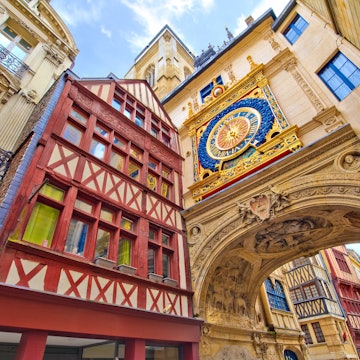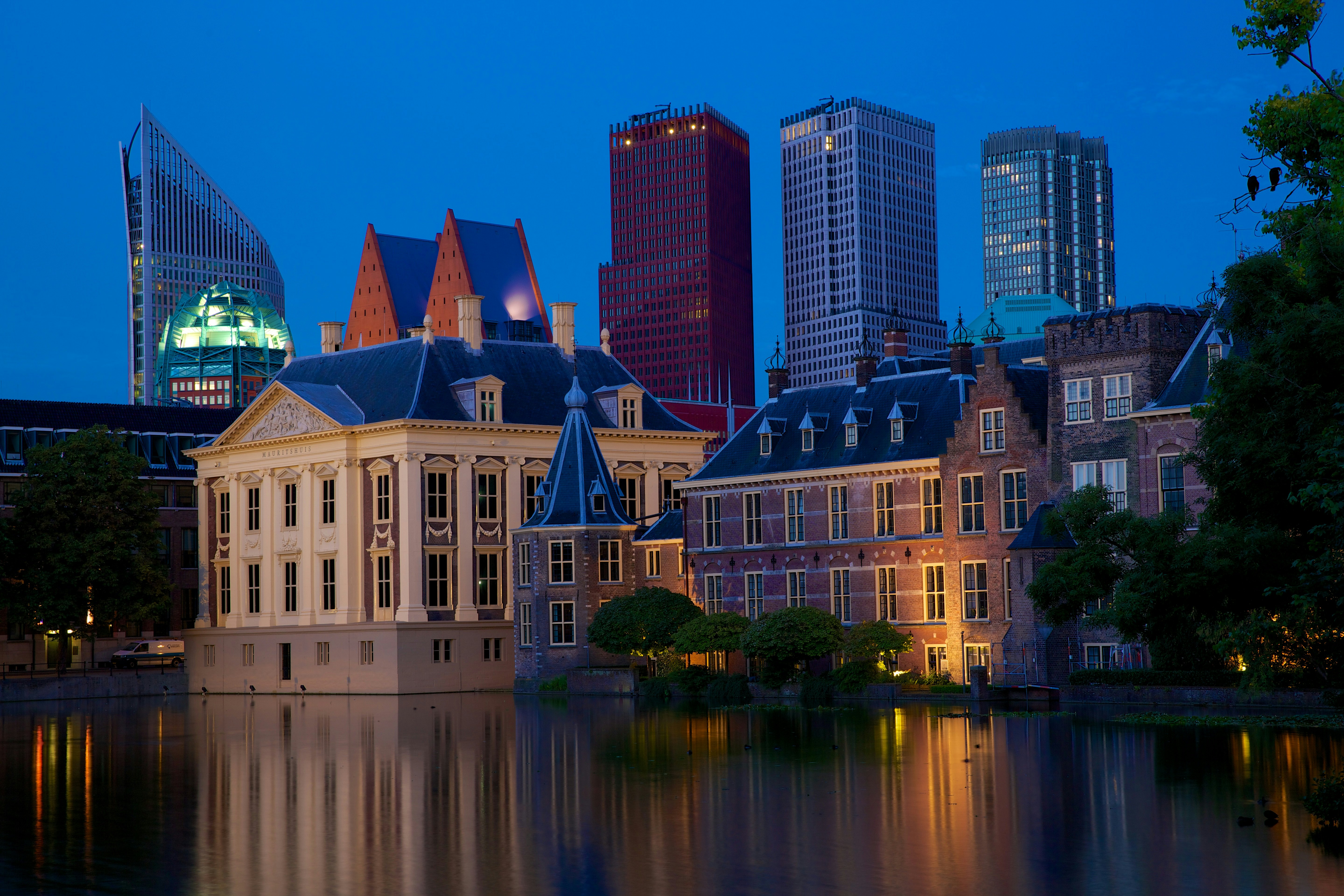
Aug 26, 20258 min read
Why you should add cultural Rouen (with its own Notre Dame) to your France itinerary
Oct 28, 2025 • 7 min read

A canal in The Hague, close to Binnenhof. Mihaiu/Shutterstock
A visit to Den Haag (The Hague), the Netherlands' administrative capital and home of its courts and governments, offers cultural and historical experiences to fill an enriching and entertaining itinerary. You can view world-famous works of art, tour the magnificent houses of the Dutch government or spend cozy afternoons and nights sipping pints in traditional bruin cafes.
Here are our top picks for what to do during your trip.

In 2003 and 2019, respectively, Dutch masterpieces Vermeer’s Girl with a Pearl Earring and Fabritius’ The Goldfinch became the centerpieces of riveting Hollywood blockbusters of the same names. Don’t miss seeing the prolific paintings at Den Haag’s splendid Mauritshuis museum. Set in a sugar trader’s 17th-century mansion, the institution houses an 800-masterpiece-strong collection of 15th- to 18th-century Dutch and Flemish art. Beyond its two big-screen starlets, equally intriguing works include Rembrandt’s The Anatomy Lesson of Dr Nicolaes Tulp, Van der Weyden’s The Lamentation of Christ ²¹²Ô»å&²Ô²ú²õ±è;³Õ±ð°ù³¾±ð±ð°ù’s View of Delft, the Dutch Golden Age’s most famous cityscape.
The list of artists goes on: in addition to more by the above Dutch greats, there are multiple pieces by Anthony van Dyke, Rubens, Jan Brueghel I, Hans Holbein II, Hals and Steen, as well as a modern art wing. A free multimedia tour is available in app stores.
Planning tip: Ticket entry also gets you through the doors of the Galerij Prins Willem V.
The king’s and queen’s official quarters at Paleis Noordeinde are not open to the public, but worth a peek through its crested gates.
Members of the Netherlands’ Orange Nassau monarchy have lived and worked here since 1595. Extensively rebuilt in the early 19th century, it now functions as King Willem-Alexander’s workplace and state office.
Admire the building’s classical facade through the barrier. The 19th-century equestrian statue out front depicts William of Orange. One of Dutch history’s most important figures, he led the Dutch revolt against the Spanish Habsburgs that set off the Eighty Years’ War (1568–1648) and resulted in the formal independence of the United Provinces in 1581.

Home to both houses of the Dutch government, the Binnenhof, adjacent to the Mauritshuis, is one of Den Haag’s most beautiful scenes. Overlooking the Hofvijver (Court Pond), the medieval palace complex is arranged around a central courtyard once used for executions. Its splendid ceremonial Ridderzaal (Knights Hall) dates back to the 13th century; the 17th-century North Wing is still home to the Upper House, but the Lower House meets in a chamber in the modern eastern part of the complex.
Planning tip: Local democracy organization conducts guided tours – around the Binnenhof and inside the Dutch House of Representatives – detailing the complex’s history and the Dutch political system.
Nestled between the Peace Palace and International Court of Justice, a modest flame has been burning within a stone pillar since 2002. Descending from a light ceremoniously ignited in Wales by the World Peace Flame Foundation in 1999, across seven lights kindled on five continents, it is a quiet symbol of global unity.
The so-called Peace Flame is even more poignantly surrounded by a small garden, comprising a stone from every UN-recognized country (at that time, 197 countries, in 2004).
Along a circular path, each piece of native geology has been meticulously arranged next to an explanation of its origins. When here, take a few moments for a somber exploration of growing peace, from a Berlin Wall remnant to a fragment of the Robben Island prison where Nelson Mandela was held.

Once home to members of the Dutch royal family, the 18th-century Lange Voorhout Palace now opulently showcases the spooky, haunting works of Dutch graphic artist MC Escher (1898–1972). The permanent exhibition features notes, letters, photos and plenty of woodcuts and lithographs from various points throughout his career, including everything from the early realism to the later phantasmagoria. Immersive multimedia conjures up a waking nightmare, blending black-and-white and gray scale, mathematical conjunctions and more WTF? moments.
Spuiplein’s striking, new cultural complex has brought together the principals of the Netherlands’ renowned performance scene under one roof.
The grand, modern structure on Spuiplein was architecturally inspired as a multiversum, with a facade resembling theater curtains. Spanning 54,000 sq meters, its concert halls stage key performances by main cultural heavyweights: the Nederlands Dans Theater, National Theatre, Koninklijk Conservatorium (Royal Conservatory) and Residentie Orkest (Philharmonic Orchestra) are all based here.
Even between performances, the space stays lively with the comings and goings across a rehearsal hall, classrooms and studios. A sustainability focus includes an organic restaurant and public-open canteen (closed summers); plus design elements like solar panels and bamboo walls, as well as facade-built birdhouses and bat roosts.

The Grote Markt party precinct and surrounding dining and shopping enclaves, like trendy Molenstraat and upscale Noordeinde, beat with diverse crowds. The streets here aren’t green and leafy like those north of the city center; rather, they’re colorful, happening at all hours with students, backpackers and boho types – ambassadors’ mansions and corporate buildings seem worlds away.
Count into your explorations the 15th-century Grote Kerk church with its merry carillon; move on to the Stadhuis (aka Ice Palace), a huge, blindingly white (and often graffitied) building housing the municipal library and tourist center. Around the precinct, grab an outdoor table for people-watching. In winter, indoor action is a melting pot of live music, beer and pub culture, across traditional bruin cafes like , live-music legend and Den Haag’s sole tiki bar, VaVoom!

Home to the UN’s Permanent Court of Arbitration and International Court of Justice, Vredespaleis (Peace Palace) is housed in a grand 1913 building donated by American steelmaker Andrew Carnegie. Its visitor center has multimedia exhibits detailing the history of both the building and the organizations within; these are enjoyed in a free 30-minute audioguide tour.
Planning tip: Hour-long guided afternoon tours of the palace are offered on weekends. Book ahead on the website to ensure your spot, though some are kept for walk-in visitors on the day (turn up at 10am to score one). A passport, EU identity card or driver’s license must be shown upon entry.
Allegedly, Van Gogh found much creativity in the bottom of a barrel at this genever distiller. Den Haag’s only surviving genever producer, now works off-site, but keeps this stop for visitors to discover its historic distillery process. Compare heady "old" genever, packed with herbs and spices (like Van Gogh once guzzled it), with its "young" successor, a cheaper, more hasty concoction popular in WWII. If you’re brave, there’s also Kruìde Baggâh, a herbal bitter whose name means "dirty herbs" – the name says it all. It’s still punchy, except made with safe, clean water that won’t leave one sprinting to the outhouse.
Displayed artifacts include drankorgels ("liquor organs") barrels tapped by patrons; and Den Haag’s first telephone book, where drinkers (maybe even Vincent himself) dialed "1" for the distillery’s "moonshine hotline."
In a fabulous art deco haven, hit three separately curated visual powerhouses in one fell swoop. The Kunstmuseum, a fine-art museum, devotes an entire wing to eye-popping De Stijl (Neoplasticism). Its major drawcard is Mondrian’s unfinished Victory Boogie Woogie, which the abstract painter worked on up until his death. Its Discover the Modern exhibit encompasses early-20th-century works by Van Gogh, Picasso, Kandinsky and others, including Egon Schiele’s exquisite Portrait of Edith.
Planning tip: Adjoining, the Fotomuseum mounts excellent snapshots (especially war photography), while KM21 curates multidisciplinary, 21st-century installations.
Situated paradoxically (or perhaps fittingly) within Den Haag, "International City of Peace and Justice" Gevangenpoort (Prison Gate Museum) provides illustrations of dubious past approaches to maintaining peace and justice. Warning: it’s child-unfriendly.
Established in 1428, the Court of Holland’s former prison primarily housed debtors and individuals awaiting interrogation and trial for plotting and disseminating dangerous ideas. Only in the 17th century did incarceration become punishment via confining suspects in dim, cramped cells over months. The museum vividly recreates an oppressive atmosphere experienced by the notable likes of Cornelis de Witt, accused of plotting against the Prince of Orange.
In a torture chamber, chilling confession-extracting instruments are displayed among thin floors and ceilings once amplifying inmates’ cries. Guided tours are available.

Plan with a local